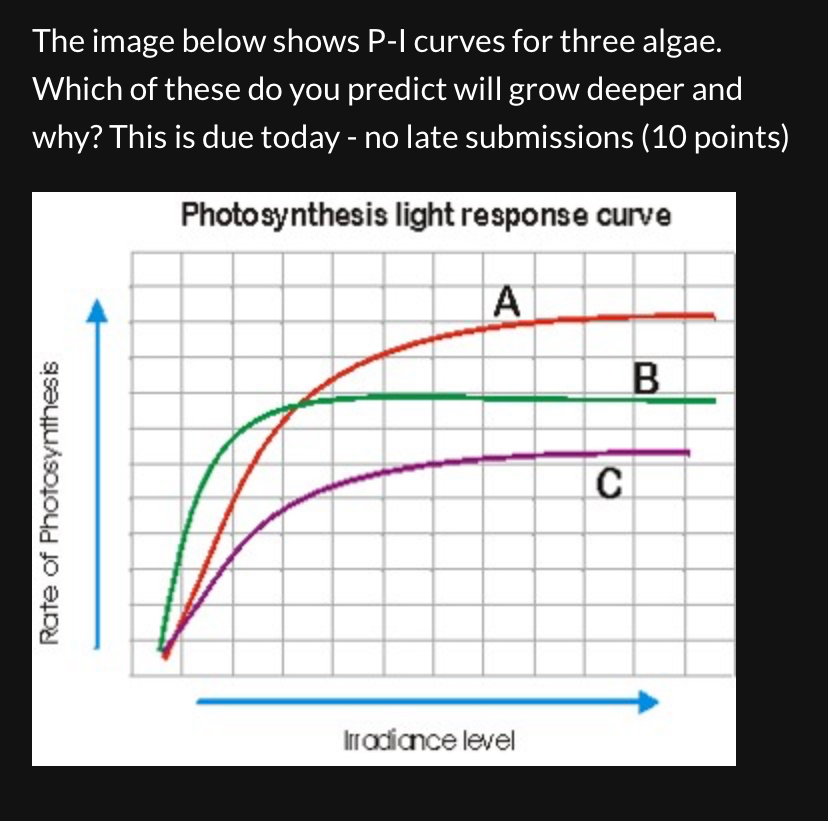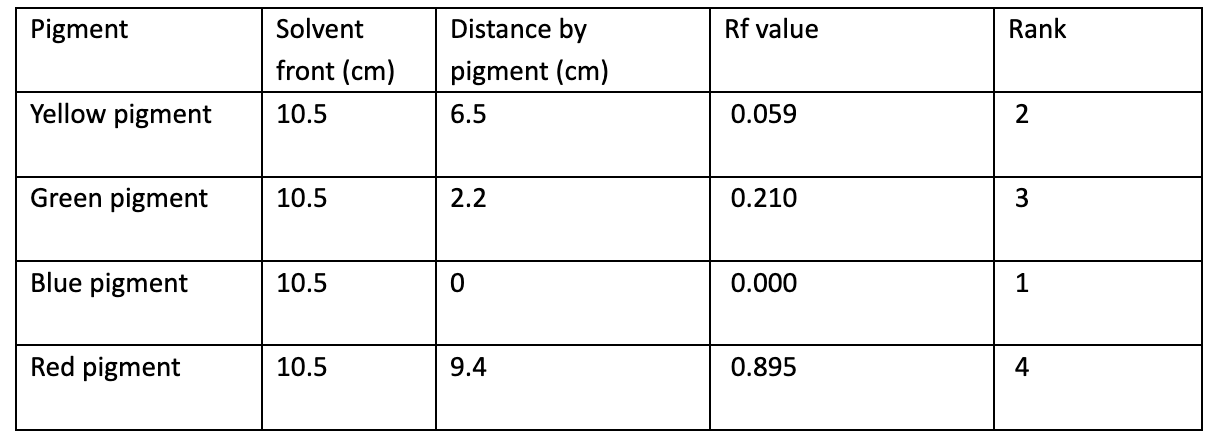362 final exam
1/62
There's no tags or description
Looks like no tags are added yet.
Name | Mastery | Learn | Test | Matching | Spaced |
|---|
No study sessions yet.
63 Terms

Which of the three algae (A, B, or C) will grow deeper and why?
B, In deeper water, light levels are lower, so algae must be able to photosynthesise efficiently under low irradiance. The key trait to look for is:
High photosynthetic efficiency at low light, which is reflected in the steep initial slope of the curve (quantum efficiency).

calculate the RF values for this and then rank them based on how hydrophilic (#1) to most hydrophobic (#4)
𝑅𝑓 = 𝐷𝑖𝑠𝑡𝑎𝑛𝑐𝑒 𝑟𝑢𝑛 𝑏𝑦 𝑝𝑖𝑔𝑚𝑒nt 𝐷𝑖𝑠𝑡𝑎𝑛𝑐𝑒 𝑟𝑢𝑛 𝑏𝑦 𝑠𝑜𝑙𝑣𝑒𝑛𝑡

Why do C4 plants appear when CO2 is low?
Avoid photorespiration by concentrating CO₂,
Are more water-use efficient,
Have an advantage over C₃ plants in low CO₂, high light, and high temperature environments.
climate change is making heat waves worse. How does this affect plants?
Effect | Consequence |
|---|---|
Photosynthesis | Lower energy, reduced growth |
Water stress | Wilting, stomatal closure |
Reproductive failure | Lower crop yields |
Cellular damage | Protein/membrane dysfunction |
Ecosystem disruption | Species composition changes |
Changing fire bushfires. How does this affect plants?
Change in Fire Regime | Effect on Plants |
|---|---|
Increased frequency | Less time to recover, seedbank depletion |
Higher intensity | Kills fire-adapted species, alters regeneration |
Changed seasonality | Disrupts growth and reproduction |
Shift in vegetation | Promotes fire-tolerant/invasive species |
What If global average temperature increases exceed 1.5–2.5 OC (with associated CO2 increase)
major changes in ecosystem structure & function & speciesʼ ecological interactions
shifts in speciesʼ geographical ranges,
negative consequences for biodiversity & ecosystem goods & services, e.g. water & food supply.
In climate change which types of species are most at risk?
Alpine, arctic, island species; those with long lifespans, slow dispersal, or isolated populations (e.g. mountaintop).
bc. they have low thermal tolerance, Low Plasticity and Genetic Diversity and are already near their max/min heat limits
What limits plant distributions?
Temperature (min/max), summer warmth, rainfall. Cold-/heat-intolerant plants define vegetation boundaries.
How does rising CO₂ affect photosynthesis?
Increases photosynthesis, stomatal conductance= Direct effects
water use efficiency (WUE), leaf temp, growth, nutrient cycling and reduces Rubisco demand.= Flow on effects
What do light response curves measure?
Photosynthetic rate vs. light intensity; used to assess plant responses under stress (e.g. drought, heat, CO₂ changes).
How do plants help mitigate climate change?
Absorb CO₂ via photosynthesis (carbon sequestration); regulate water, protect soil, support biodiversity.
How do C₃ and C₄ plants differ under high CO₂?
C₃: Downregulate photosynthesis (less Rubisco), lower leaf N; growth varies.
C₄: Some show increased photosynthesis — not always saturated at current CO₂.
What plants grow in Antarctica?
mostly mosses/ bryophytes and some grass species
How do plants in Antartica protect themselves from UV light? due to the hole in the ozone
Mechanism | Function |
|---|---|
Flavonoids | Absorb/block UV radiation |
Antioxidants | Detoxify harmful ROS |
DNA repair | Fix UV-induced mutations |
Thickened epidermis/cuticle | Reflect or block UV |
UVR8 receptor | Senses UV-B, triggers defence pathways |
What are the main groups of photosynthetic pigments?
Chlorophylls (a+b), Carotenoids (Beta-carotene), Phycobilins (phycoerythrin)
Why is it useful to have more than just chlorophyll?
1.Broader Light Absorption Spectrum (Chlorophyll a absorbs mostly blue and red light, but not green/yellow, Accessory pigments capture different wavelengths, expanding the usable light range.)
2. Energy Transfer via Resonance
(Light energy absorbed by accessory pigments is transferred non-destructively to chlorophyll a in the reaction centre, This resonance energy transfer makes the system more efficient and prevents energy loss.)
Where does the light energy go after it's absorbed?
When pigments like chlorophyll absorb light, photoexcitation occurs: An electron jumps to a higher energy level.
Photochemistry (most useful):
The excited electron is used in photosynthesis (starts electron transport chain in PSII/PSI).
Resonance Energy Transfer:
Energy is passed to another pigment molecule (not the electron itself), until it reaches the reaction centre.
Fluorescence (only if energy isn’t used):
The excited chlorophyll returns to the ground state and releases light (usually red) — a sign that energy was not captured productively.
Heat Dissipation:
Excess energy is safely released as heat, especially under stress to prevent damage.
Photoexcitation
Absorption of light raises chlorophyll's electron to a higher state
Fluorescence
Emission of light when excited chlorophyll returns to ground state
What is the Calvin-Benson Cycle?
The light-independent stage of photosynthesis that uses CO₂, ATP, and NADPH to make sugars.
What are the 3 phases of the Calvin Cycle?
Carbon fixation (Rubisco adds CO₂ to RuBP)
Reduction (3-PGA → G3P using ATP/NADPH)
Regeneration (G3P regenerates RuBP)
What is Rubisco?
An enzyme that fixes CO₂ to RuBP. It's slow and can also bind O₂ (leading to photorespiration).
Why is photorespiration wasteful?
because Rubisco binds O₂ instead of CO₂, consuming energy and releasing CO₂ instead of fixing it.
How does temperature stress affect the light response curve?
Reduces Pₘₐₓ; curve flattens due to Rubisco inefficiency and increased photorespiration.
How does drought affect the light response curve
Lowers Pₘₐₓ and LSP due to stomatal closure and reduced CO₂ uptake.
How does elevated CO₂ affect the light response curve?
Increases Pₘₐₓ, especially in C₃ plants, improving carbon fixation efficiency.
Sun vs. Shade Plants: How do their light response curves differ?
Sun plants: higher Pₘₐₓ & LCP, lower initial slope
Shade plants: lower Pₘₐₓ, lower LCP, higher initial slope(more efficient at low light).
Why do plants need to overcome photorespiration?
Because it wastes energy and carbon — Rubisco fixes O₂ instead of CO₂, releasing CO₂ and using ATP without making sugars.
What triggers photorespiration?
High temperatures, low internal CO₂ (often due to stomatal closure), and high O₂/CO₂ ratios
What is the common factor in C₄ and CAM plants that helps avoid photorespiration?
Spatial or temporal separation of carbon fixation and the Calvin cycle to concentrate CO₂ near Rubisco.
How do C₄ plants avoid photorespiration?
By fixing CO₂ in mesophyll cells with PEP carboxylase, then transporting it to bundle sheath cells for the Calvin cycle (spatial separation).
How do CAM plants avoid photorespiration?
By fixing CO₂ at night and storing it as malate, then releasing it for the Calvin cycle during the day (temporal separation)
What is the role of stomata in gas exchange?
They open to allow CO₂ in for photosynthesis and release water vapour through transpiration.
What happens when stomata close during heat or drought?
CO₂ can't enter → photosynthesis slows → internal O₂ builds up → photorespiration increases.
How are stomata linked to water and heat regulation?
Open stomata allow transpirational cooling, but also lead to water loss. Closed stomata conserve water but risk overheating and reduced CO₂.
What is a key advantage of CAM photosynthesis?
Great water-use efficiency – stomata open at night when water loss is lower.
What is a drawback of CAM photosynthesis?
Slow growth – CO₂ storage is limited, so carbon fixation rate is lower than in C₃.
What’s an advantage of C₃ photosynthesis?
Faster growth in moist, temperate environments with adequate CO₂ and open stomata.
What’s a downside of C₃ under stress?
Susceptible to photorespiration and water loss when stomata closes.
How do plants deal with varying light levels?
They adjust leaf anatomy, pigment content, and energy dissipation (e.g., via photoprotection) to optimise photosynthesis and prevent damage.
photoinhibition
Damage or reduced efficiency in photosynthesis caused by excess light (more than the plant can use).
What factors can limit photosynthesis?
Light intensity
CO₂ availability
Temperature
Water supply
Nutrient availability (especially nitrogen for Rubisco)
How do sun and shade plants differ in photosynthesis?
Trait | Sun Plants | Shade Plants |
|---|
Pₘₐₓ | High | Low |
LCP (Light Comp. Pt) | Higher | Lower |
Chlorophyll content | Lower total, more a | Higher total, more b |
Light-use efficiency | Lower (at low light) | Higher (steeper initial slope) |
What pigment helps shade plants maximise light absorption?
Chlorophyll b – allows use of lower-energy light (green/yellow range).
photoprotection
The plant's ability to lose excess light energy to avoid damage to the photosynthetic machinery.
What is the difference between internal and external photoprotection?
Internal: Mechanisms within the chloroplast (e.g. xanthophyll cycle, antioxidant enzymes)
External: Leaf movement, trichomes, wax layers, or epidermal pigments that reduce light entry
xanthophyll cycle
process where pigments like violaxanthin are converted to zeaxanthin to safely dissipate excess light as heat.
What pigments are involved in the xanthophyll cycle?
Violaxanthin → Antheraxanthin → Zeaxanthin (under high light)
Zeaxanthin returns to violaxanthin under low light
What are the main types of pigments in photoprotection?
Chlorophylls – light capture
Carotenoids – photoprotection (e.g., xanthophylls, β-carotene)
Anthocyanins – absorb excess light in the epidermis; protect against UV
sunfleck
A brief burst of sunlight that penetrates through the canopy, providing intermittent light in otherwise shaded environments.
Why are sunflecks important for shade plants?
Sunflecks can provide 30–80% of daily light for understory plants — being able to quickly use this light is crucial for photosynthesis and growth.
What is induction in photosynthesis?
The process of activating the photosynthetic machinery (e.g., Rubisco, electron transport, stomatal opening) after a period of low light or darkness.
Why is Rubisco activation important in induction?
Rubisco must be carbamylated and activated to fix CO₂ — delayed activation limits how fast a plant can respond to sudden light increases like sunflecks.
What is post-illumination response?
The lag in photosynthetic activity returning to low/light-off levels after high light exposure — often due to slow deactivation of enzymes or residual heat dissipation.
How is excess light dealt with during sudden exposure (e.g. sunflecks)?
Through photoprotective mechanisms like the xanthophyll cycle, non-photochemical quenching (NPQ), and antioxidant systems that safely dissipate energy.
What is the trade-off between photoprotection and induction?
Photoprotection (e.g. NPQ) protects the plant during high light but takes time to relax → can limit photosynthesis during short sunflecks if the plant can’t switch quickly between low and high light use.
Which plants are best adapted to use sunflecks efficiently?
Shade-tolerant species with fast induction responses, quick Rubisco activation, and flexible NPQ relaxation.
what do pigments in plants do?
Molecules that absorb specific wavelengths of light, playing key roles in photosynthesis and photoprotection.
Why are pigments important
Enable light absorption for photosynthesis
Provide photoprotection from excess light
Help in energy transfer between molecules
Absorb UV light (protect DNA & proteins)
Influence leaf colour and seasonal change
What are the main types of pigments in plants?
Chlorophyll a – main photosynthetic pigment
Chlorophyll b – expands light absorption
Carotenoids (e.g. β-carotene, xanthophylls) – photoprotection & accessory light harvesting
Anthocyanins – absorb UV, protect from oxidative stress, give red/purple colour
What’s the role of the xanthophyll cycle in pigments?
It allows dissipation of excess energy as heat via pigment conversion (e.g. violaxanthin ↔ zeaxanthin).
What does chlorophyll fluorescence tell us?
It provides insight into photosystem II efficiency, energy dissipation, and plant stress status.
What is a SPAD meter used for?
A non-destructive tool to estimate relative chlorophyll content in leaves.